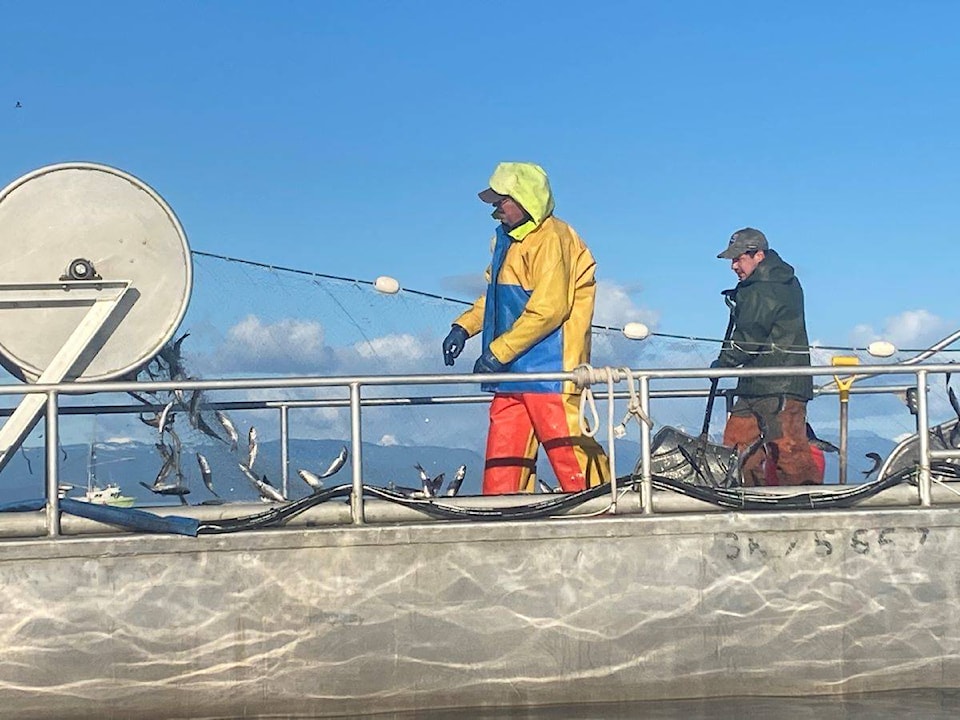The herring are back, though not exactly where or when some might expect.
Fisheries and Oceans Canada (DFO) was posting fisheries updates a couple of times a day during the week of March 8. Early on, the numbers were closer to the low end of projections for the Strait of Georgia as laid out in the Integrated Fisheries Management Plan (IFMP). These were listed as “incomplete.” Some in online discussions observed the spawn was late and not necessarily where expected.
By mid-week, as the roe herring fishery opened on March 10, the estimate for spawning biomass tonnage in the region was higher than the median projection of just over 90,000 metric tonnes. The projections in the IFMP ranged from 44,500 up to 155,600.
As of March 12, the tonnage for the Strait of Georgia was showing 106,000. Of this, 89,000 was in Area 14, which includes Baynes Sound locations. The 89,000 is considered the “peak” estimate, or the total estimated for an area, though DFO cautions these in-season estimates are incomplete and do not form the basis of the final herring stock assessment.
RELATED STORY: Some want quota cuts to herring fishery around Baynes Sound
RELATED STORY: Hornby Island group wants roe herring moratorium
From the commercial seafood industry, the Herring Conservation and Research Society’s Rob Morley told the Record that reports from test vessels and soundings from the fishing grounds showed plenty of herring, enough to meet at least the amount forecast.
Morley said there was a lot of spawning in the north of the area, beyond Cape Lazo, though he expects the spawning period is far from over. As far as the later timing of fishes’ arrival, he said it still falls within the normal window
“Historically, herring can spawn in the Strait of Georgia anywhere from the last week of February until late March,” he said.
That the fishery is happening at all is a concern to some. On March 10, the group Conservancy Hornby Island (CHI) issued a news release saying scientists, First Nations leaders and communities such as Hornby are calling for a more cautionary approach than the IFMP’s 20 per cent harvest rate.
“In simple terms, the current DFO science does not meet international standards for a sustainable fishery,” CHI ocean conservationist Locky MacLean said in the release.
The release also includes statements from Dr. John Neilson, former DFO scientist emeritus, and W̱SÁNEĆ First Nation Hereditary Chief Eric Pelkey.
CHI chair Grant Scott told the Record he was seeing spawning at locations such as the east coast of Denman Island and the northeast coast of Hornby Island. However, he added that spawning seemed to be occurring more at the furthest points of Area 14, such as north of the airport in Comox, or south around Parksville, rather than points in between.
The fish do move, posing questions about the DFO estimate, or as Scott put it, “How many times are those fish getting measured? They’re moving around. They’re not sitting there.”
On top of this, he added, the federal government approach only seems to consider the fishery itself and not the many factors that can affect herring populations such as water temperatures or predators.
Beyond the estimates of the spawning biomass, the important number for CHI is that four of the five major Pacific herring stocks in B.C. have collapsed in a relatively short time frame, leaving the Strait of Georgia as the sole one. Scott said he understands the people fishing to try to make a living, but when it comes to economic arguments, the herring industry is getting less significant. At the same time, the fish provide the basis of the food system for salmon and orcas, which the fisheries department, he said, is not considering.
“They don’t want to hear the environmental side,” Scott added. “We don’t want it to be five out of five.”
CHI, he said, would like to see a moratorium to allow the herring to repopulate, as well as a buyback program of fishing licences and retraining for workers. “We want jobs, we want to support people,” he added.
According to a DFO spokesperson, the department conducts a comprehensive annual stock assessment program based on catch, biological sampling and spawn deposition data. They make in-season estimates from soundings used to guide the herring fishery and identify where potential fishing opportunities exist. Final estimates for the spawning biomass though are available in a stock assessment report released in September. This allows for fishing plans to be adjusted each year.
To Scott, this practice is part of the problem with DFO’s management of the fishery.
“They plan the fishery all around last year,” he said. “Herring are very variable.”
mike.chouinard@comoxvalleyrecord.com
Like us on and follow us on .



